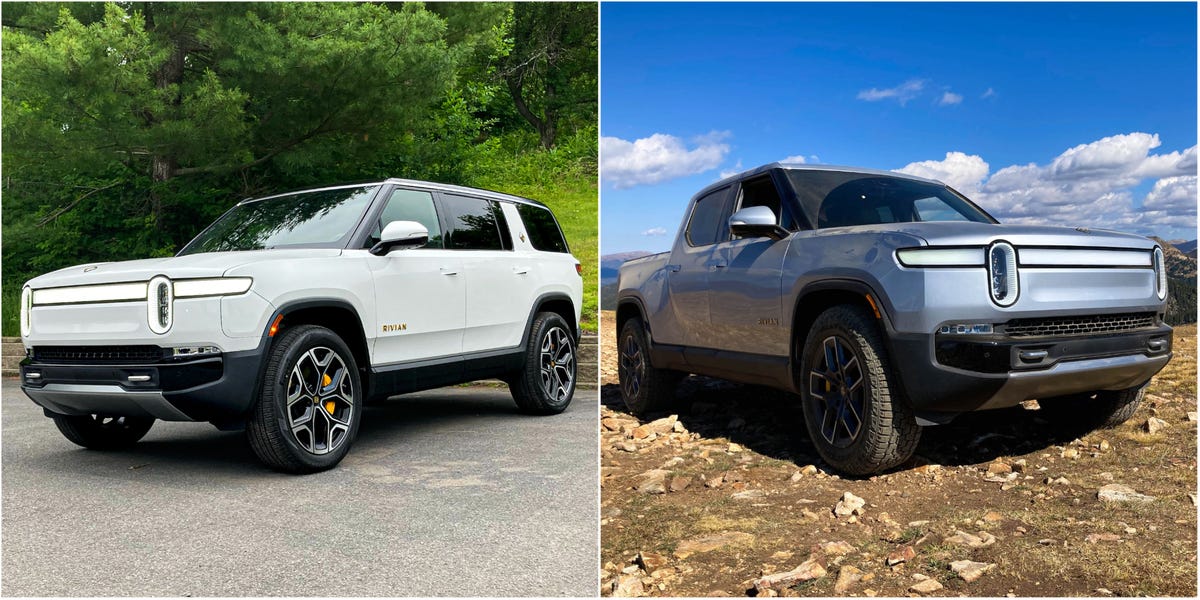- Tesla is facing competition from new and exciting startups.
- Rivian is one of the most successful electric-vehicle startups in the US.
- The Tesla Model X and upcoming Cybertruck pickup will compete with Rivian’s R1T pickup and R1S SUV.
For decades, a handful of Goliaths have dominated the auto industry. But the era of electrification has opened the door for smaller startups to enter the conversation.
California-based Rivian is one new firm competing with Tesla and gunning for a slice of the burgeoning electric-vehicle market.
I drove vehicles from both Rivian and Tesla to see how the up-and-comer compares to the EV industry leader.
What is Tesla?
Tesla birthed the EV market as we know it and remains the most successful seller of electric cars in the world. China’s BYD is right on its tail, but in the US no competitors come close.
The Tesla Model Y compact SUV is the world’s best selling vehicle. Its second most popular offering is the Model 3 sedan. The Elon Musk-led automaker also sells two bigger, higher-end models: the Model S sedan and Model X SUV (that’s the one with the wild, falcon-wing doors.)
What is Rivian?
Lots of EV startups have hit the scene trying to emulate Tesla’s gangbusters success. Only a couple have managed to build vehicles and ship them to customers at any sort of scale. One of those lucky few is Rivian.
The California-based company was founded in 2009 by RJ Scaringe, who remains its CEO. Along the way, it racked up major investments from Amazon, Cox Automotive, Ford, and other big backers.
In late 2021, it officially launched its first vehicle, the R1T pickup truck. It was the first electric pickup of the modern electric era, followed by offerings from Ford and GM. In mid-2022, it started selling the R1S, a big SUV based on the same platform as the R1T.
Rivian also produces a delivery van for Amazon.
All of Rivian’s vehicles are built at its factory in Normal, Illinois. Rivian is working on a second factory in Georgia where it plans to manufacture its next generation of vehicles, which will be smaller and cheaper.
How do Tesla and Rivian’s vehicles compare?
While Tesla’s bread and butter is modestly sized sedans and SUVs, Rivian is catering toward buyers who want a larger vehicle and better off-road capability. Rivian’s brand is all about getting outdoors, so its high-end vehicles are kind of like a cross between Tesla and Jeep.
I’ve driven both the R1T and R1S and found both incredibly impressive.
They’re cool-looking, extremely capable, and packed with thoughtful features. The R1T, for example, has an ingenious Gear Tunnel that lets you stash things between the pickup’s cab and bed. Both vehicles offer four motors, an adjustable-height suspension, and multiple drive modes that make crawling over the most treacherous obstacles a walk in the park.
The R1T is about the size of a Toyota Tacoma and costs $73,000 to start. The three-row R1S is roughly the size of a BMW X7 and starts at $78,000. Tesla’s Model X SUV costs $98,490 and up. Rivian should soon get another competitor in the form of the Tesla Cybertruck, which will supposedly hit streets this year.
Tesla doesn’t have the same sort of nature-loving ethos. Its cars are more about on-road performance, and they deliver that in spades, particularly if you choose a sportier model, liek the Tesla Model S Plaid.
Still, there’s some overlap between Tesla and Rivian’s vehicles.
Both brands embrace simplicity and technology in the Rivian and Tesla interior, which look nothing like what you’d get from a conventional automaker. Tesla was the first company to eliminate most physical buttons and use a big touchscreen instead, and Rivian followed suit.
Both interfaces feel snappy and modern, but both can be frustrating to use when you want to adjust a simple setting while driving. Both Teslas and Rivians require swiping the touchscreen to change the direction of the air vents, for example.
How do you buy a Tesla or a Rivian?
A perk of buying from either brand is seamless online ordering. Both reject traditional dealers and instead sell vehicles direct-to-consumer through their websites.
Read the full article here




